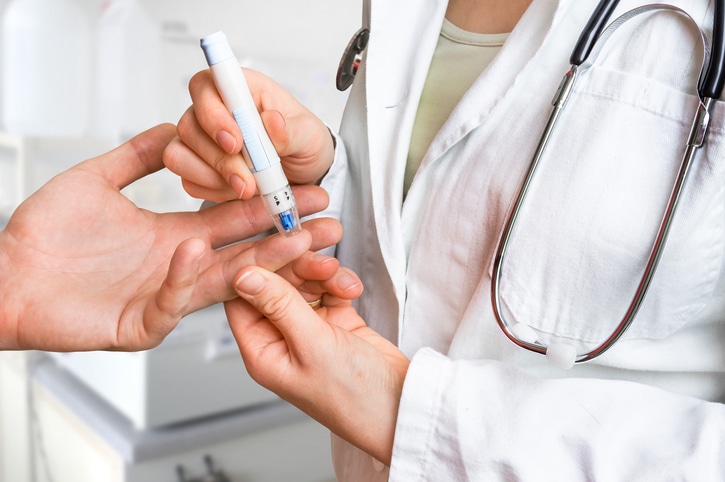The numbers show just how widespread the diabetes problem is becoming in the United States. Figures from the American Diabetes Association illustrate that about 10% of all Americans are diabetic. This percentage is even higher among seniors, with one-quarter of all Americans age 65 and older qualify as diabetic. There is good news, though. In many cases, diabetes is a preventable condition. We’ll take a look at two different types of diabetes mellitus in this article, the risk of diabetes developing, and what you can do to help prevent yourself from becoming diabetic.
Type 1 Diabetes
There are several categories of diabetes, but the main two are called type 1 and type 2. Type 1 diabetes mellitus (T1DM) is actually an autoimmune disorder. In other words, people with T1DM have faulty immune systems that attack their own healthy cells. Specifically, T1DM patients’ immune systems kill off the beta cells in their pancreas.
The beta cells of the pancreas produce insulin, a hormone that regulates blood sugar levels and makes sugar available for use as energy by your body. However, those with T1DM produce very little or no insulin. They must take insulin injections to keep their blood sugar levels under control. In the past, T1DM was often known as insulin-dependent diabetes or juvenile diabetes.
Onset of T1DM is typically in childhood or adolescence, but it is a life-long condition. T1 diabetics tend to have a thin build, but this is not a hard and fast rule. Currently, T1DM cannot be managed without insulin, although patients may also take additional medications.
Non-Controllable Type 1 Diabetes Risk Factors
T1DM has a strong hereditary component. The condition often runs in families, and you have a greater risk for T1DM if you have a relative with the disease. Also, having certain genes may put you at a higher risk for T1DM.
Controllable Type 1 Diabetes Risk Factors
There are currently no known controllable risk factors for this autoimmune disorder.
Type 2 Diabetes
Previously called adult-onset or non-insulin dependent diabetes, type 2 diabetes (T2DM) is a metabolic disorder. In this condition, patients’ beta cells begin to “burn out” or die off due to struggling to constantly produce sufficient insulin to handle a high blood sugar load. Your body may also become resistant to insulin.
Although T2DM can sometimes be controlled through diet and exercise, many patients with T2DM need to take oral medications as well. Eventually, a significant percentage of people with T2DM end up needing to add injectable insulin to their medication regimen. T2DM patients are typically overweight or obese, and many also suffer from metabolic syndrome. This syndrome represents a number of medical issues including high blood pressure, unhealthy cholesterol levels and fatty liver disease.
Most T2DM patients are over the age of 45, but more and more young people are becoming type 2 diabetics. The disease can even appear in children. T2DM represents around 95% of diabetes mellitus cases in the United States, with T1DM only making up about 5%.
Non-Controllable Type 2 Diabetes Risk Factors
There are a few non-controllable risk factors for T2DM, including:
- Age over 45
- Having a near relative with T2DM
- Having had gestational diabetes, a form of diabetes during pregnancy, in the past
- Race: Caucasians are at the lowest risk for T2DM, while African-Americans, Native Americans, Hispanics, and some Asian-Americans have an elevated risk.
Controllable Type 2 Diabetes Risk Factors
Fortunately, some major risk factors for T2DM are controllable, meaning you can take steps to reduce or eliminate these risk factors. One major T2DM risk factor is being overweight. Another is a sedentary or inactive lifestyle. Eating healthy, especially a limited-carbohydrate diet, and getting regular exercise – greater than three times per week – will go a long way toward helping you prevent T2DM. If you need help, reach out to your primary care physician. They can provide you with weight loss guidance and connect you with specialists, like nutritionists, who can also assist you.
Diabetes Symptoms to Watch Out For
It’s important to know that a positive family history of diabetes is not required for you to develop either type of diabetes. So, even if none of your relatives has T2DM, you can still become diabetic, especially if you disregard your controllable risk factors. For this reason, you need to be aware of diabetes symptoms. Both T1DM and T2DM have similar signs, including:
- Excessive thirst
- Increased frequency of urination
- Blurred vision
- Unexplained fatigue
- Increased hunger
- Unexplained weight loss
If you have any of these symptoms, or want to discuss how you can reduce your risk of diabetes, let your primary care physician know right away. The test for diabetes can be completed in a single day, and diabetes always needs treatment to avoid life-threatening complications in the short term and long term damage to multiple organ systems.
Looking For a Primary Care Doctor in Connecticut?
PACT Primary Care is Accepting New Patients!
Locations throughout Connecticut in Guilford, Hamden, Madison, Milford, New Haven, Orange, West Haven and Wallingford.
To schedule an appointment, request an appointment online here or call a local center near you.








